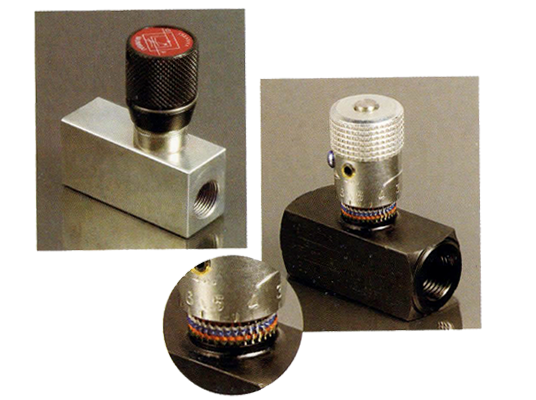
Vitrag International is recognized as one of the leading Manufacturer and Supplier of Shutoff Valves,
Needle Valves, Non-Return Valves, Relief Valves, Reducing Connections, Stand Pipes Adaptors,
Rotary Fittings, Sea Flanges Flow Control Valves, Hydraulic Flanges & Components, Flareless
Hydraulic Fittings, PVC Pipe Clamps, Pipe & Pipe Fittings, Hydraulic Hoses & Accessories, Valves
and Fittings Accessories, Couplings, UHMWPE Products Etc.
Non-Compensated Flow Control Valves
Non-compensated Flow Control Valves are devices used in hydraulic and pneumatic systems to
regulate the flow rate of a fluid without adjusting for variations in pressure. Unlike compensated flow
control valves, which automatically adjust to maintain a constant flow rate despite changes in
pressure, non-compensated flow control valves do not have this capability.
Types of Non-Compensated Flow Control Valves
Fixed Orifice Valves: These have a set, non-adjustable opening through which the fluid passes. The
flow rate is determined by the size of the orifice and the pressure difference across it.
Adjustable Orifice Valves: These allow manual adjustment of the orifice size, enabling the user to
set the desired flow rate. The flow rate will still vary with pressure changes.
Needle Valves: These are a type of adjustable orifice valve with a tapered needle that fits into a
conical seat. By turning the needle, the user can finely adjust the flow rate.
Advantages of Non-Compensated Flow Control Valves:
Non-compensated flow control valves, also known as simple flow control valves, are widely used in
various hydraulic and pneumatic systems. They offer several advantages that make them suitable for
particular applications.
• Cost-Effectiveness: Non-compensated flow control valves are generally less expensive than
their compensated counterparts. This cost advantage makes them an attractive option for
budget-sensitive projects or applications where precise flow control is not critical.
• Simplicity: These valves are mechanically simpler, with fewer components compared to
pressure-compensated or temperature-compensated flow control valves. This simplicity
translates to easier installation, maintenance, and troubleshooting.
• Reliability: With fewer moving parts and simpler mechanisms, non-compensated flow control
valves are often more reliable and less prone to failure. This makes them suitable for
applications where maintenance access is limited or difficult.
• Low Maintenance: The straightforward design of non-compensated flow control valves
means they require less frequent maintenance and are easier to repair if issues arise. This can
reduce downtime and maintenance costs over the long term.
• Ease of Adjustment: These valves allow for straightforward manual adjustment of flow rates.
This can be beneficial in systems where flow requirements change occasionally and can be
adjusted by an operator.
• Versatility: Non-compensated flow control valves can be used in a wide range of applications,
including those with varying pressure conditions, as long as precise flow control is not a critical
requirement.
• Immediate Response: Non-compensated flow control valves can offer immediate response
to flow adjustment without the delay that might occur in more complex compensated systems.
This can be important in applications where quick adjustments are necessary.
• Energy Efficiency: In systems where pressure variations are minimal or controlled, non-
compensated flow control valves can be more energy-efficient because they do not require the
additional mechanisms that compensated valves do, which can sometimes consume additional
energy.
• Compact Design: The simpler design of non-compensated flow control valves often allows for
a more compact form factor, which can be beneficial in applications with limited space.
• Wide Range of Materials and Sizes: These valves are available in a variety of materials and
sizes, making them suitable for different fluid types and operational environments, including
those with specific chemical compatibility or temperature requirements.
Technical Specification of Non-Compensated Flow Control Valves:
• Inline and Subplate mounted with Colour flow Calibrated Scale.
• Size 1/8" to 2" BSP / NPT Screwed ends.
• Inline full flow check valve and soft seal poppets provide dead tight shut off ultimate in flow
metering.
• Capacity 0 to 160 GPM flow rate.
• PRESSURE - 2000 PSI for Brass and 5000 PSI for steel valves.
Non-Compensated Flow Control Valves application industries:
Hydraulic Systems : Used in machines where consistent flow is required for operations like pressing,
cutting, and lifting. Essential in equipment like excavators and loaders where precise control of
hydraulic fluid is necessary.
Manufacturing : Used to control the speed of actuators and other pneumatic or hydraulic devices.
Employed in controlling the movement of tools and workpieces in CNC machines and other precision
tools.
Automotive : Ensures proper fluid flow in various hydraulic systems used in the manufacturing
process. Used in test rigs for components like brakes and steering systems to control hydraulic fluid
flow during testing.
Agriculture : Helps in controlling water flow to ensure efficient and effective irrigation. Utilized in
hydraulic systems of tractors and harvesters for controlling implements and attachments.
Oil and Gas: Used in hydraulic systems to control the flow of drilling fluids and other hydraulic fluids.
Employed in various processes where fluid flow needs to be controlled, such as in wellhead control
systems.
Water Treatment: Ensures the correct flow rate of water through filters and other treatment units.
Used to control the flow of water through various stages of treatment and distribution.
Pharmaceuticals and Biotechnology: Used in bioreactors, mixers, and other equipment where
precise control of fluid flow is essential for process integrity. Employed in devices that require
controlled flow of fluids for experiments and production of pharmaceuticals.
Food and Beverage: Ensures the correct flow of ingredients and products through processing
stages. Used to control the flow of products into packaging machines.
Aerospace: Used in ground testing equipment to simulate conditions and control hydraulic systems.
Employed in the production of aircraft components where precise fluid control is necessary.
Marine: Used in steering systems, winches, and other onboard hydraulic applications. Controls the
flow in various hydraulic systems used on platforms for drilling and production operations.